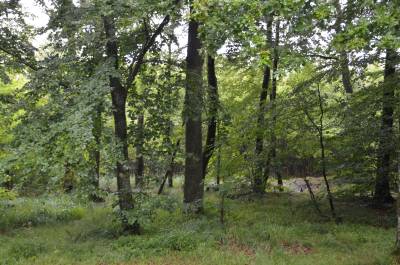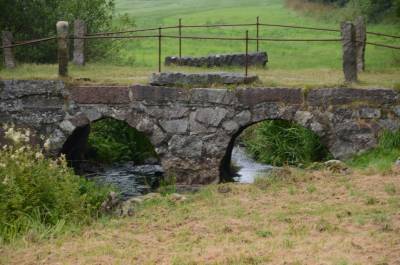Sausages, bridges and thing.
Notice that only two of the words in the heading is plural while the last is singular for which there is a good reason that will be revealed later on. It was now the day before the day of our return to civilization or at least to our home. Back home we had planned quite a lot for this day, and we actually saw a lot. Just not what we had planned, but a lot of other places. The day before, we had been in Højer trying to get sausages with no luck as according to the saleslady, they wouln'd keep fresh in our hot trunk of the car for three days, but now that we had discovered that our room actually had a refrigerator, we decided to go back and get some. Besides that Tim had discovered that a couple of his friends that he hadn't seen for five years, were vaccationing in Højer (Facebook is a wonderful thing - at times). He had been in contact with them, and he had promised that we would visit them for a cup of coffee.
 So the first leg of the trip took us straight to Højer and the sausage
factory. I bought a few different kind of sausages to take home, before we
continued to Tim's friends. We spent around an hour there, having a cup of
coffee and chatting. Then we took off again. Højer is a bit isolated, where the
geest turns to marsh not far from the ocean or rather The Wadden Sea. The coastline used to be much further east, where today
is land, and Tønder used to be a port. We returned east to the old town of
Møgeltønder. It originally meant Large Tønder, but today, Tønder is much
larger than Møgeltønder. Here we turned north to the small settlement, Gallehus. This place is
famous as the finding place of The Golden Horns of Gallehus, two golden horns
from the iron age, found in 1639 and 1734. The horns, date back to the early 5th century. The horns
were stolen many years ago and melted down, but today copies exist in The
National Museum of Denmark. In Gallehus two stones has been erected on the
finding places, which were only about 10 meters (30 feet) apart. After having
taken some pictures of the two stones, we continued our trip.
So the first leg of the trip took us straight to Højer and the sausage
factory. I bought a few different kind of sausages to take home, before we
continued to Tim's friends. We spent around an hour there, having a cup of
coffee and chatting. Then we took off again. Højer is a bit isolated, where the
geest turns to marsh not far from the ocean or rather The Wadden Sea. The coastline used to be much further east, where today
is land, and Tønder used to be a port. We returned east to the old town of
Møgeltønder. It originally meant Large Tønder, but today, Tønder is much
larger than Møgeltønder. Here we turned north to the small settlement, Gallehus. This place is
famous as the finding place of The Golden Horns of Gallehus, two golden horns
from the iron age, found in 1639 and 1734. The horns, date back to the early 5th century. The horns
were stolen many years ago and melted down, but today copies exist in The
National Museum of Denmark. In Gallehus two stones has been erected on the
finding places, which were only about 10 meters (30 feet) apart. After having
taken some pictures of the two stones, we continued our trip.
Next stop was Draved Skov (Draved Wood). This is a small forested area between Tønder and Løgumkloster. This is not really a pristine forest, but what is called "untouched forest". The idea is to let the forest develope by itself. Nothing is planted and nothing is cut down. That means the the different species of trees grow where the soil is suitable for them. The soil is rather moist (Draved actually means "swamp") and the wood is dominated by trees like oak, linden and alder, but other deciduous trees are found as well. After a short walk in the woods we returned to the car and headed north to the small town, Løgumkloster. Here we visited the rather large church, that used to belong to an abbey, but the abbey is long gone and only a few remains can be seen. But the church from the 13th century is impressive. We stayed here for a while looking at the alter, the baptistery and the pulpit which are the most interesting things. The dormitory and the chapterhouse are all that are left of the old monastey, and we visited those as well, before leaving Løgumkloster and heading east.
Our next goal was Hoveslund Stationsby, or rather a couple of places outside this village. The first stop we made at Hærulfstenen, The Hærulf Stone, an old rune stone from the 9th or 10th century, with only the name Hærulf inscribed on it. The inscription in old norse is HariwulfR, which may be translated into Warrior-Wolf. From there we continued about 1 km (0.6 miles) down the road to Immervad Bro, an old bridge that originally carried Hærvejen across Rudbæk Å, a small creek. The present stone bridge was built in 1786 as a replacement of an older wooden bridge, and it is constructed like the older wooden bridge. Probably several wooden bridges has predated the present bridge, as Hærvejen has been used for many hundreds or maybe thousands of years. But the "vad" in the name, indicates, that there used to be a place here, where the creek could be forded.
From Immervad we headed south on Hærvejen to our next goal, Urnehoved Ting. Urnehoved Ting (Urnehoved Thing) was the thing of Sønderjylland from early medieval times or even before that until around 1525. At this thing, local policies were discussed, disagreements between nobles and citizens were settled and trials were held. In 1133 Harald Kesja was hailed as king here, but not in any other parts of Denmark. here, his halfbrother Erik Emune was hailed, even if Niels at the time was still the ruling king. When Niels died in war in 1134, Erik had Harald and Niels' son Magnus killed, and was hailed as king of all Denmark. But already in 1137 Erik was killed at another meeting at Urnehoved Ting most likely by a nobleman, Sorte Plov, that supported Niels. The exact spot of the old thing is not known today, but a memorial has been erected on one of the likely spots, and that was the place we visited.
 Urnehoved
is close to the small village Bolderslev, which I have visited on other
occasions, but not this time. Local folklore tells that on this place once (many
hundred years ago) lived a King Bolder. (This seems like as "Bolder" or
Balder as modern linguists translate it, is mans name and "lev" means
either "a place where you make a living" or "heirlooms"). This king Bolder was at war with a neigboring king, Hother or Høther. Bolder
lost the war and was killed, but someday he will return from the dead and regain
his kingdom. If you know the norse mythology you will recognize a distorted
version of the myth of Baldr and his twin brother Höðr. For my part I think it's
the other way around though. That the story of the real persons, Bolder and Høther, was somehow
distorted and incorporated in the mythology when it was written down on Iceland
several hundred years later.
Urnehoved
is close to the small village Bolderslev, which I have visited on other
occasions, but not this time. Local folklore tells that on this place once (many
hundred years ago) lived a King Bolder. (This seems like as "Bolder" or
Balder as modern linguists translate it, is mans name and "lev" means
either "a place where you make a living" or "heirlooms"). This king Bolder was at war with a neigboring king, Hother or Høther. Bolder
lost the war and was killed, but someday he will return from the dead and regain
his kingdom. If you know the norse mythology you will recognize a distorted
version of the myth of Baldr and his twin brother Höðr. For my part I think it's
the other way around though. That the story of the real persons, Bolder and Høther, was somehow
distorted and incorporated in the mythology when it was written down on Iceland
several hundred years later.
Anyway we continued south on Hærvejen and visited two more bridges, Povls Bro and Gejlå Bro. Like Immervad Bro they are around 200 years old and have replaced older wooden bridges. From the southernmost of the bridges we continued to Frøslevlejren, which none of us had visited before. Frøslevlejren or Frøslev Prison Camp, was an internment camp during German occupation of Denmark in World War II. It was created by Danish authorities i 1944 in an attempt to avoid that Danes were transferred to concentration camps in Germany. Even so 1,600 of the around 12,000 prisoners were deported even so, and 250 died in the concentration camps. Today the camp serves a museum and some of the shacks houses other museums, as well as an Efterskole. (A definition of Efterskole can be found on Wikipedia). We walked around the camp and visited the museum, before heading back to Sønderborg.
On our way back we passed through the small village, Rinkenæs; where we stopped to take some pictures of the town sign, mostly because Rinkenæs appears in an old childrens song, that most children still sing. "Rapanden Rasmus fra Rinkenæs Sogn - in English something like "Rasmus the Duck from Rinkenæs Parish". Rapand is a childrens expression for duck - as "rap" is the sound Danish ducks uses, not "quack" as English speaking ducks :-). From Rinkenæs we continued to Dybbøl, a famous place in Danish history, unfortunately most famous for the serious defeat Denmark suffered to Prussian troops in 1864. When we got there it was raining heavily, so we didn't feel like walking around the sconces, so all we did was to take some pictures of the famous mill that todays is a national landmark. Then we returned to our bed and breakfast, so I could get my sausages into the refrigerator. Later we had dinner in Sønderborg and the we returned to the B&B to pack our stuff and make ready for the trip home to Brøndby.